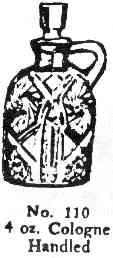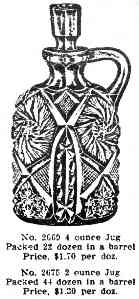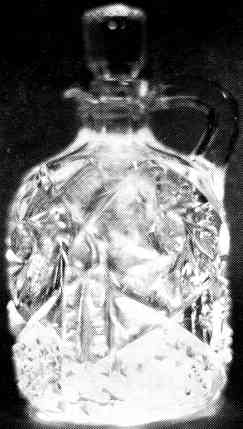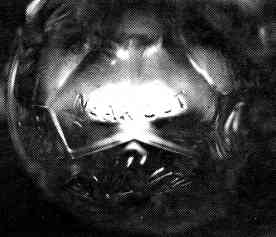The Jug with the Hidden Trademark
by Joseph A.A. Bourque Sr.
Issue 294, October 1997
Dear Reader,
In 1970, I had occasion to note a small Near Cut Cambridge Glass
4-oz handled cologne No. 110, depicted in a Cambridge Catalog reprint (left).
 (See Figure 1 Welker I-116)
(See Figure 1 Welker I-116)
Since I had taken a fancy to small collectibles, I locked this item in my mind, hoping for the day I would find one. Twenty-five years later, an article appeared in the Crystal Ball, (March '95 issue) referring to a small Near Cut jug. It was written by Bud Walker.
Walker wrote that it bore a Near Cut signature inside the jug.
 Having not seen, heard, nor read
about this before, I found it most interesting. He went on to say that
his friend Willard Kolb had informed him that in order to make such a
jug, it required a certain device called a "Cut-Shut" mold. The 1910
Nearcut Catalog Reprint - 84 shows a little 4-oz. jug No. 2669 (See
drawing at right). It appears to be the same as the 4-oz. handled
cologne.
Having not seen, heard, nor read
about this before, I found it most interesting. He went on to say that
his friend Willard Kolb had informed him that in order to make such a
jug, it required a certain device called a "Cut-Shut" mold. The 1910
Nearcut Catalog Reprint - 84 shows a little 4-oz. jug No. 2669 (See
drawing at right). It appears to be the same as the 4-oz. handled
cologne.
I attended our NCC Convention '97, and made it a point to see Bud Walker and Willard Kolb about this hidden signature inside a jug. I met Willard after not having seen him for over 20 years, and he explained to me how the Cut-Shut method worked.
Now bear in mind that I had been looking for this elusive jug and/or handled cologne for over 25 years, with negative results. As Willard and I parted that evening, I told him jokingly that since he had given me all the data he had on the Cut-Shut jug, I would go our first thing in the morning and find one. We both laughed at this as we parted company.
The next morning, I read my daily agenda. Heading the list was: "Visit Harold and Judy Bennett - Shop & Museum." So off I went to Judy's Antique Shop. It was good to see Judy Bennett again after such a long time. We talked a bit. She informed me that Harold would be across the street (his Cambridge museum) in a short while.
As my eyes darted about the numerous pieces of Cambridge glass treasures, they stopped and gazed in wonder at a pressed-cut miniature handled jug. I actually became awestruck as I gently picked it up from the shelf, suddenly releasing years of pent-up search and pursuit. At long last I had found this select Cambridge miniature.
It was baffling. I waited 27 years to find this little jug, yet
after only a short 12-hour time Period of being told what a
 Cut-Shut little jug would look like by Kolb and Walker, I came up
with this little gem with stopper (at left). I made several other
purchases, but all were secondary compared to my little jug.
Cut-Shut little jug would look like by Kolb and Walker, I came up
with this little gem with stopper (at left). I made several other
purchases, but all were secondary compared to my little jug.
I eventually crossed the street, met Harold Bennett, and chatted for about a good hour about old times. One interesting thing he told me was that he owned the Cambridge trademarks. I had visited Harold Bennett two or three times in the early '70s when he was running the Guernsey Glass Company. I recall that he had made some items bearing the Near Cut trademark. One of these items was a large pink slag pitcher in the Strawberry pattern. I informed him that I still had one of these with the six tumblers, all signed Near Cut. He offered to buy the set from me. "Not right away," I retorted. I mentioned the little Near Cut jug. We looked for one but could not find it on display. We parted company, and I went to my room.
The first thing I unwrapped was the jug and stopper. Then two nice things happened. I suddenly realized that the jug was too small to contain four liquid ounces. In searching through my Nearcut book, just under the description of the 4-oz. jug, it stated: No. 2675, 2 oz. Jug. The smaller, the better, I thought.
I have since measured it for contents, and it holds two liquid ounces.
As I was checking out the pressed-cut designs of the jug to see if
they matched those shown in the catalog, I saw some printed letters on
 the jug. A closer look proved them to be inside this little jewel of a
jug, and they read NEAR CUT. I was alone, but I shouted "Eureka!" You
can see the NEAR CUT trademark in the closeup at right.
the jug. A closer look proved them to be inside this little jewel of a
jug, and they read NEAR CUT. I was alone, but I shouted "Eureka!" You
can see the NEAR CUT trademark in the closeup at right.
I had been under the impression that the Near Cut signature would be on the inside bottom of the jug. It was signed just below the neck, running parallel to the collar.
That evening, I showed my new find to Willard Kolb and Bud Walker. They showed great interest, and verified it to be a Cut-Shut item. I had, miraculously so, kept my promise to find that Cut-Shut jug with the hidden signature that morning.
At a later time, I will attempt to tell and show you how the Cut-Shut method works.
Until next time,
Joe
